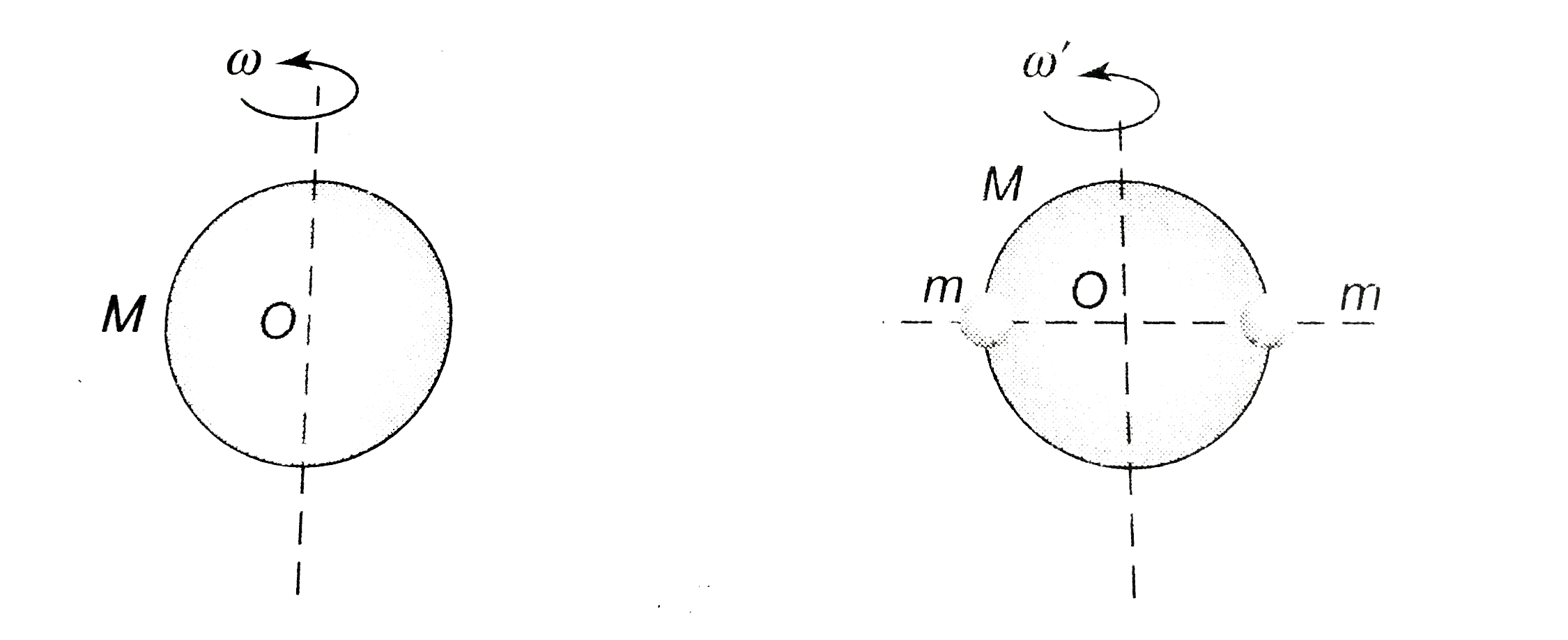A thin uniform circular disc of mass M and radius R is rotating in a horizontal plane about an axis passing through its center and perpendicular to its plane with an angular velocity ω. Now two particles each of mass m are placed on its perimeter along a diameter along a diameter. Find the new angular velocity. If m=M/2, find the percentage change in the angular velocity.

As there is no external torque, hence by the conservation of angular momentum
I1ω1=I2ω2
12MR2ω=(12MR2+mR2×2)ω'
ω'=MωM+4m
If m=M2,ω'=MωM+4×M2=ω3
Percentage change in the angular velocity
=ω3=ωω×100=−66.7%
66.7% decrease.
Topper's Solved these Questions
Similar Questions
A thin uniform circular disc of mass M and radius R is rotating in a horizontal plane about an axis passing through its centre and perpendicular to its plane with an angular velocity ω. Another disc of the same dimensions but of mass M/4 is placed gently on the first disc co-axially. show that angular velocity o fthe system is 4ω/5.
View SolutionA thin uniform circular disc of mass M and radius R is rotating in a horizontal plane about an axis passing through its centre and perpendicular to its plane with an angular velocity ω. another disc of the same dimensions but of mass M/4 is placed gently on the first disc coaxially. The angular velocity of the system now is 2ω/√5.
View Solution
Knowledge Check
- Question 1 - Select One
A thin uniform circular disc of mass M and radius R is rotating in a horizontal plane about an axis passing through its centre and perpendicular to its plane with an angular velocity ω. Another disc of same dimensions but of mass M/4 is placed gently on the first disc coaxially. The angular velocity of the system now is
A2ω√2B4ω5C5ω4D3ω4 - Question 2 - Select One
A thin uniform circular disc of mass M and radius R is rotating in a horizontal plane about an axis passing through its centre and perpendicular to its plane with an angular velocity ω . Another disc of same dimensions but of mass 14 M is placed gently on the first disc co-axially. The angular velocity of the system is
A23ωB45ωC34ωD13ω - Question 3 - Select One
A thin and circular disc of mass m and radius R is rotating in a horizontal plane about an axis passing through its centre and perpendicular to its plane with an angular velocity ω . If another disc of same dimension but mass ml4 is placed gently on the first disc co-axially, then the new angular velocity of the system is
A5ω/4B2ω/3C4ω/5D3ω/2
A thin uniform circular disc of mass M and radius R is rotating in a horizontal plane about an axis passing through its centre and perpendicular to its plane with an angular velocity ω. Another disc of the same dimension but of mass M/4 is placed gently on the first disc coaxially. Show that the angular momentum of the system is 45ω.
View SolutionA thin uniform circular disc of mass M and radius R is rotating in a horizontal plane about an axis passing through its centre and perpendicular to its plane with an angular velocity ω. Another disc of same thickness and radius but mass 18M is placed gently on the first disc co-axially. The angular velocity of the system is now
View SolutionA thin uniform circular disc of mass M and radius R is rotating in a horizontal plane about an axis passing through its centre and perpendicular to the plane with angular velocity ω. Another disc of same mass but half the radius is gently placed over it coaxially. The angular speed ofthe composite disc will be:
View SolutionA ring of mass m and radius r rotates about an axis passing through its centre and perpendicular to its plane with angular velocity ω. Its kinetic energy is
View SolutionA ring of mass m and radius r rotates about an axis passing through its centre and perpendicular to its plane with angular velocity ω. Its kinetic energy is
View Solution

